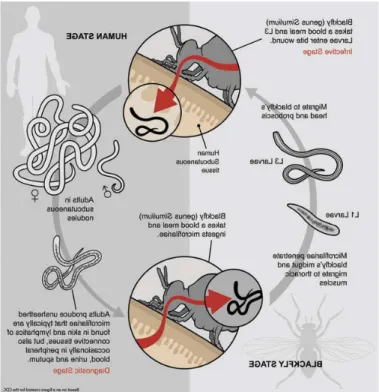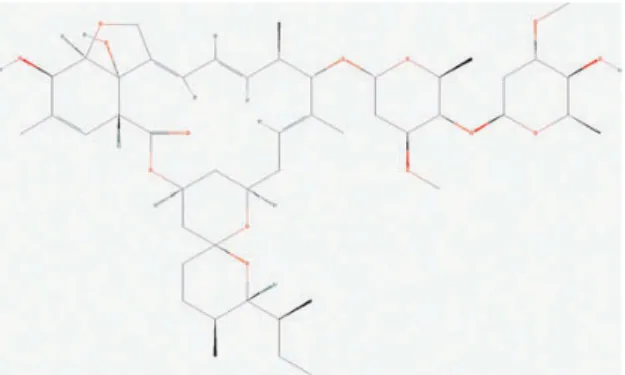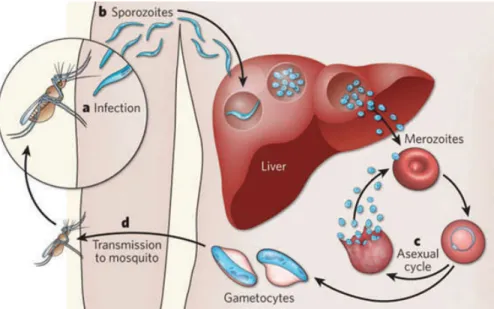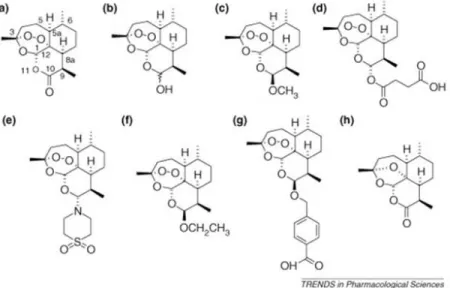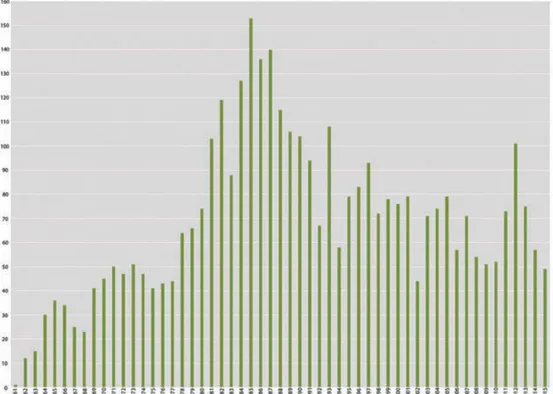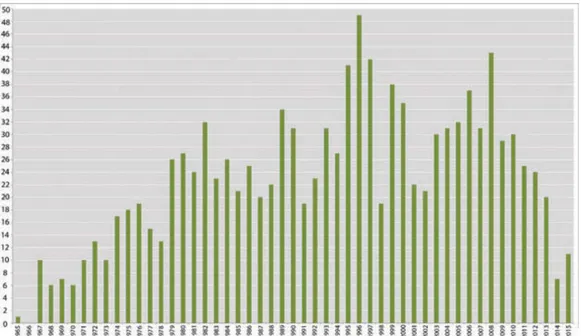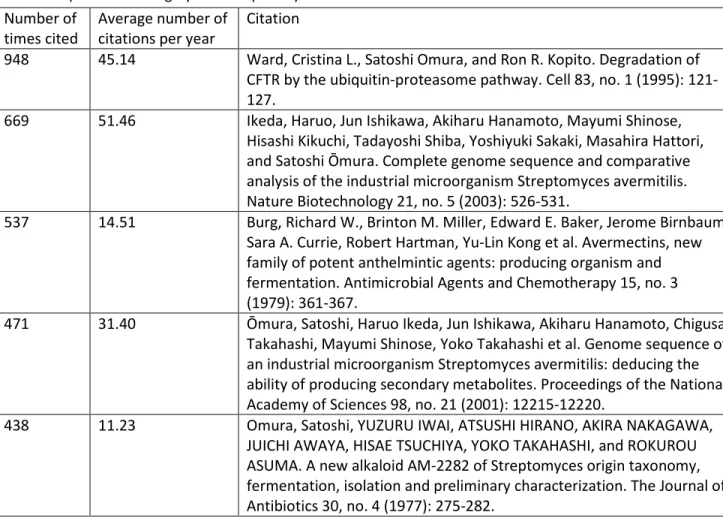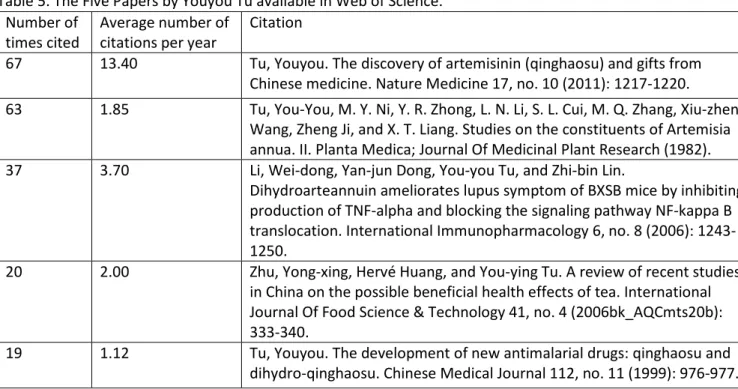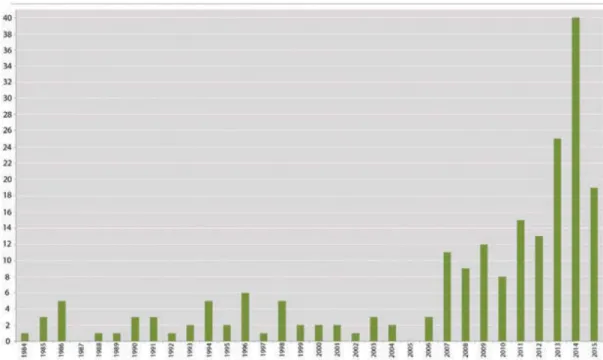Analysis for Science Librarians of the 2015 Nobel Prize in Physiology or Medicine:
The Life and Work of William C. Campbell, Satoshi Ōmura, and Youyou Tu
Neyda V. Gilman
Colorado State University, Fort Collins, CO Abstract
Parasites affect humans worldwide with varying degrees of seriousness. Some of the most impactful parasitic infections affect millions of people, many of whom are already impoverished and struggling. The discoveries of the 2015 Nobel Laureates in Physiology of Medicine have changed the way some of these serious parasitic infections are treated, saving and improving the lives of countless people. These Laureates are William C. Campbell, Satoshi Ōmura, and Youyou Tu.
Introduction
The Centers for Disease Control (CDC) lists over 100 parasitic diseases in their “Alphabetical Index of Parasitic Diseases” (Centers for Disease Control and Prevention 2013). These diseases are caused by a variety of parasites including roundworms (nematodes), flatworms (flukes), arthropods (lice, mites, etc.), and protozoans. While some parasites are harmless, or have minimal effects on their hosts, others can be
extremely detrimental and even deadly. Some of these harmful parasites have caused so much damage in part because there was no way to control them. When a method of control is discovered, and is successful,
mankind benefits. It is for this benefit to mankind that three scientists have been awarded the 2015 Nobel Prize for Physiology or Medicine. William C. Campbell and Satoshi Ōmura share half of this year’s prize for their “discoveries concerning a novel therapy against infections caused by roundworm parasites,” while Youyou Tu was awarded the other half of the prize for her work leading to “discoveries concerning a novel therapy against Malaria” (Nobelprize.org 2015a).
Satoshi Ōmura made the initial discovery that would lead to the avermectin drug series when he found, isolated, and cultured a novel Streptomyces species near a golf course in Japan (Nobelprize.org 2015c; Ōmura 2011). He discusses the rare Streptomyces avermectinius and the fermentation process used to isolate avermectin in an article with Burg et al. (1979). William C. Campbell and his team received isolates from Ōmura and discovered the anthelmintic compound that later became avermectin (Campbell 1984). Youyou Tu’s discovery followed a different path, but still relied on nature. She researched ancient Chinese herbal treatments and was able isolate to the antimalarial compound from Artemisia annua (sweet wormwood) which has now become the drug artemisinin (Tu 2011).
These discoveries led to medications that have saved and improved countless lives. Avermectin and its
derivatives are used for a variety of nematode and arthropod parasitic infections in both humans and animals, while artemisinin and its derivatives are a pivotal part of the combination therapy currently used against malaria.
2 The science
Parasites are organisms that live in or on other organisms, and in the process cause damage to the host organism. In humans, there are three classes of parasites that cause damage and disease. The first class consists of protozoa, which are single celled organisms that can multiply in humans. Protozoans are classified into four groups based on how they move: ameba, flagellates, ciliates, and non-motile adults called sporozoa. The second class of parasites that are infectious to humans are the helminths, which are further classified into flatworms (flukes and tapeworms), thorny-headed worms (acanthocephalins), and roundworms (nematodes). Finally, there are ectoparasites, which are parasites that live externally on humans, rather than internally (Centers for Disease Control and Prevention 2014).
Nematodes
There are numerous nematodes that cause disease in humans, and others that cause disease in animals, including animals that humans rely on for food, work, and companionship. Nematode infections are usually associated with impoverished and marginalized communities. People in these communities face many hardships, and parasitic infections add to their burdens by causing pain and health issues. Parasitic infections can also create social stigma due to physical manifestations such as disfigurement, as well as economic hardship due to inability to perform physical labor and loss of work animals and livestock to infection (Andersson, Forssberg, and Zierath 2015).
The life cycle of nematodes vary, but they usually require a vector host, such as fly or mosquito, to transmit the parasite. Since most nematodes do not selfreplicate in humans, it is the repeated exposure to the parasite through the vector host that causes most of the clinical symptoms in humans. This repeated exposure is only possible in endemic areas, which tend to be the more marginalized parts of the world (Andersson, Forssberg, and Zierath 2015).
Onchocerciasis (river blindness) is one of the diseases that has been alleviated by the discovery of avermectin. It is caused when Onchocerca volvulus filariae are transmitted to humans by Simulium black flies, which breed in fast-flowing waters such as rivers. Once an individual is bitten by Simulium, the young worms enter the body and travel to subcutaneous tissue where they create nodules while they mature to adults. Once mature, thousands of microfilariae are released and travel through the body where they die, or are picked up by the bite of another vector. It are these microfilariae that lead to the variety of skin conditions and vision problems, including blindness. Prior to avermectin there was inadequate treatment for Onchocerca, and insecticides were relied upon in an attempt to control the population of black flies (Crump and Omura 2011).
Similar to river blindness, lymphatic filariasis affects millions of people and is caused by a filarial infection. In the case of lymphatic filariasis, which manifests as elephantiasis, lymphedema, and scrotal hydrocele, the infecting organism could be Wuchereria bancrofti, Brugia malayi, Brugia timori, or Brugia pahangi, all of which are transmitted by mosquito. After the worms enter the human body they mature into adults in the host’s lymphatic vessels. This leads to pain, disfigurement, and swelling (Crump and Omura 2011; Moreno et al. 2010). See Figure 1 for a sample life cycle of Onchocerca volvulus.
3
Figure 1. Image showing the life cycle of Onchocerca volvulus (Source: Basáñez M-G, Pion SDS, Churcher TS, Breitling LP, Little MP, Boussinesq M (2006) River Blindness: A Success Story under Threat? PLoS Med 3(9): e371. doi:10.1371/journal.pmed.0030371, CC-BY.) Avermectin
In 1973 Kitasato Institute in Japan and Merck & Co. Inc. in the United States of America began a collaboration that initially focused on antibacterial activity. It was this collaboration that eventually led to the discovery of avermectin (Campbell 2012). The first step in this discovery was achieved by Satoshi Ōmura at Kitasato. Dr. Ōmura collected various samples of Streptomyces and was able to isolate and culture various strains, some of which were later found to be new discoveries. The fact that he was able to culture so many strains was critical, since Streptomyces is notoriously difficult to culture (Ōmura 2011). The strain that ultimately led to
avermectin was Streptomyces avermitilis, which was one of about 50 promising cultures Ōmura chose, from thousands of original cultures, to use for production of secondary metabolites (Burg et al. 1979). S. avermitilis was later renamed S. avermectinius after the genome sequence was studied (Andersson, Forssberg, and Zierath 2015).
Ōmura sent his isolates to Merck, where they were investigated for antibacterial uses. Campbell discovered the anthelmintic properties of S. avermectinius (avermitilis) when these isolates arrived in the parasitology department to be studied for their impact on poultry coccidiosis. One mouse, which almost died before its time, was the singular mouse that showed anthelmintic properties (Campbell 2012). Tests later determined that the mouse had almost died from toxicity caused by oligomycin, a toxic compound produced by
Streptomyces organisms. Ōmura was able to refine the culture to remove the oligomycin and send new
samples to Campbell. These new samples were used in subsequent tests that confirmed the anthelmintic activity (Ōmura 2011).
Thomas W. Miller worked closely with Campbell at Merck to characterize the newly identified compound. These compounds were named the avermectin group, and they became the first of the macrocyclic lactones.
4
Macrocyclic lactones are compounds that are derived from Streptomyces organisms and act against nematodes or insects.
The avermectin group exists in two series, A and B. Each series has structural subsets, 1 and 2, and further major and minor subcomponents, a and b, leading to a group consisting of eight structures: A1a, A1b; A2a, A2b; B1a, B1b; B2a, B2b (Campbell 2012). These eight structures have structural differences at carbon 5, carbons 22-23, and carbon 26 (Yoon et al. 2004). The difference between the two subsets is that subset 1 has an olefinic bond (an unsaturated, double bond) between carbons 22 and 23 (C22-23), where subset 2 has a hydrated bond. This means that rather than C22-23 having a double bond, as in subset 1, subset 2 has a hydroxyl group (OH−) that bonds to carbon 23 making the C22-23 a single bond. After more testing at Merck, it appeared that this C22-23 single bond was desired, but the associated hydroxyl group was not. The desired compound with the single bond, but without the hydroxyl group, was theorized to have improved efficacy and safety than either of the subgroups alone. Selective hydrogenation of the B1 structure created a semisynthetic derivative which had the desired structure. This compound was named ivermectin, and it is the primary avermectin compound in use today (Campbell et al. 1983) (see Figure 2).
Figure 2. Chemical structure for ivermectin. (Structure retrieved from PubChem CID 6321424.)
In his 1983 article, Campbell notes that the United States livestock industry faced an economic loss more than $3 billion annually due to parasitic infections, most of which were due to nematodes and arthropods. It was this problem that initially interested Merck. The avermectin drug family was shown to be effective against “plant parasitic and free-living nematodes,” as well as arthropods. In addition, ivermectin was shown to be effective against many nematodes and arthropods affecting animals. After numerous successful tests in animals, Campbell proposed human testing in 1977. However, initial human testing was disappointing since adult parasites were not affected by the drug. Subsequent studies using the drug against different Onchocerca species (the genus of the cause of river blindness) in horses and cows showed success and led to further human testing. This additional human testing found that ivermectin is lethal to young Onchocerca, and is damaging, though not lethal, to adult worms (Campbell 2012). The first of these human studies involved 42 West African men and demonstrated the apparent effectiveness and safety of ivermectin for treatment of human infections of Onchocerca (Aziz et al. 1982). A review by Cupp et al. (1986) suggests that in addition to being a potent treatment for Onchocerca, ivermectin also lowers the transmission rate of the disease. With the success of ivermectin against Onchocerca, interest grew in studying the drug against other helminth diseases. Just five years after Aziz’s study, Diallo and colleagues (1987) showed promising results using
ivermectin against another chronic and devastating disease, lymphatic filariasis. Another first occurred in 2004 when ivermectin was created by another laboratory outside of Merck and used in a study. That study, which took place in Brazil, showed that ivermectin could be used to simultaneously treat intestinal and cutaneous parasitic infections (Heukelbach et al. 2004).
5
According to Campbell’s 2012 review, as early as 1975 avermectin had been shown to be potent, active orally as well as parenterally, active against a wide range of intestinal nematodes and some extraintestinal parasites, active against a few internal parasites even with external application, active against nematodes that were resistant to benzimidazole, and relatively safe. By 1976 it was also shown to be effective against some insect and acarine parasites (mites, ticks, etc.). In addition, ivermectin can act as a preventative treatment for heartworms in dogs and cats. A literature search on the subject shows that additional studies have looked at the effect of combining ivermectin with other drugs such as doxycycline and milbemycin oxime (Giannelli et al. 2013; Snyder et al. 2011).
The mode of ivermectin is still not known in detail. It is suggested that it inhibits glutamate-gated chloride (GluCl) channels and GABA-activated chloride channels in invertebrate muscle and microfilaria nerve cells (Campbell et al. 1983; Wang and Pong 1981). In his 1983 article, Campbell discusses research into the mode of action of ivermectin. Findings suggested that in nematodes the drug acts as a signal transmission blocker between interneurons and excitatory motoneurons by blocking the neurotransmitter γ-aminobutyric acid (GABA) that regulates chloride ion channels. Subsequent studies showed non-GABA sensitive muscles
responding to ivermectin and some GABA channels not reacting. These results suggest that the GABA mode of action may be incorrect. Studies in the late 1980s and 1990s showed that ivermectin actually acted on
glutamate-gated (GluCl) chloride channels which are only present in invertebrates (Martin, Robertson, and Wolstenholme 2002).
In Campbell’s initial studies of the mode of ivermectin, he hypothesized that ivermectin inhibited the affected channels, thus causing an increase in the cell membrane’s permeability to chloride ions. This resulted in hyperpolarization of the cell. The hyperpolarization was believed to cause paralysis and a slow death of the parasite, minimizing inflammation to the host. A 2010 study by Moreno et al. suggests that ivermectin’s activity on the GluCl channels actually suppresses the parasites’ secretion of proteins, which allows the parasite to more effectively evade the host’s immune system. Although Moreno’s study support this
hypothesis, there is no data addressing the lack of effect against adult worms and there is no direct evidence to date showing the relationship between ivermectin treatment and improved immune response to the parasite.
Since the GluCl channels are only present in invertebrates, the drug is considered safe to use on both humans and animals. Ivermectin thus acts on the nerves of the parasites while not affecting those of the host. Studies looking at dosage of ivermectin on a variety of filariae show that ivermectin acts as a microfilaricide (killing immature worms). However, low dosages of ivermectin did not lead to a sustained absence of worms. Slightly larger dosages not only eliminated the young worms, but kept them away for longer. This suggests that larger doses of ivermectin have an effect on the ability of adult worms to produce more microfilariae (Ottesen and Campbell 1994).
Although ivermectin does not kill all parasites present in or on the host, and thus does not cure the disease, it is an extremely effective treatment. In the case of river blindness and lymphatic filariasis, the immature worms (microfilaria) cause the swelling, sores, blindness, etc., and thus removing them removes the symptoms. In addition, the drug inhibits the adult worms (macrofilaria) slowing down the reproduction cycle, even after repeated exposures. In some cases, as with river blindness, ivermectin use is sufficient in keeping the disease controlled. Other times, as with lymphatic filariasis, ivermectin is used in tandem with another drug. In the case of lymphatic filariasis, ivermectin acts as a microfilaricide killing immature filariae and weakening adults, while the tandem drug albendazole acts as a macrofilaricide against the adult worms (Campbell 2012).
6
The news coverage of the Nobel has emphasized the impact on onchocerciasis (river blindness) and lymphatic filariasis as these diseases affect millions. However, ivermectin has been beneficial in treating a number of diseases worldwide. Other major parasites that ivermectin is used against include Loa loa and Mansonella
ozzardi, as well as a wide variety of other endoparasites. In addition, ivermectin is effective against
ectoparasites such as lice, mites, ticks, and hornflies (Crump and Omura 2011; Ottesen and Campbell 1994). A more recent study suggests that ivermectin could be used against bedbugs, which were shown to be affected after feeding on humans who had taken the drug (Sheele et al. 2013).
Besides ivermectin, there have been other drugs developed from the avermectin group. These include: abamectin, doramectin, selamectin, milbemycin oxime, nemadectin, moxidectin, and eprinomectin (Campbell 2012; Pitterna et al. 2009). The avermectin drugs have shown to be extremely useful. Not only do they play a vital role in human health, including the treatment and possible elimination of certain parasitic diseases, they also are used in agriculture to improve both animal and plant health. A literature search in Web of Science of “avermectin OR ivermectin” found 7,692 results on 1 November 2015. These articles demonstrate the wide use of avermectin and its derivatives in a variety of research areas, including veterinary medicine and zoology, entomology, agriculture and food science, environmental science, tropical medicine and pharmacology, in addition to parasitology, immunology, and microbiology. These 7,692 articles have been cited 123,220 times (including self-citations) in 42,631 articles.
In 1987, Merck officially donated ivermectin for use in Onchocerca control. According to Crump’s 2011 summary, this donation of ivermectin was the start of a $9.2 billion philanthropic movement of medical donations that has benefited billions of people. The CDC classifies both onchocerciasis and lymphatic filariasis as “Neglected Tropical Diseases,” and both now are targeted for elimination by 2020 or soon after.
Malaria
Malaria is a disease caused by protozoa parasites in the Plasmodium genus. There are five species of
Plasmodium that infect humans: P. falciparum, P. vivax, P. ovale, P. malariae, and P. knowlesi, all of which are
transmitted to humans by the female mosquitoes of the genus Anopheline. Sporozoites that are deposited by the mosquito in the human host travel to the liver where they infect the liver cells (hypnozoites) and split into thousands of merozoites. The merozoites leave the liver and enter the red blood cells, where they reproduce and cause symptomatic malaria. P. falciparum and P. vivax account for the greatest number of complications and death, while P. vivax and P. ovale infections are known to cause relapses due to dormant liver hypnozoites that later activate and continue dividing and invading red cells (Centers for Disease Control and Prevention 2012; Xu 2014) (see Figure 3). Typical symptoms include fevers with cold, hot, and sweating stages. Patients can also experience headaches, diarrhea, and abdominal pain. When the parasite in question is P. falciparum, reproduction can take place in the capillaries of internal organs. This may lead to additional symptoms, depending on the affected organ, such as cerebral malaria, shock or renal failure, acute respiratory distress syndrome, or hemoglobinuria (black urine). In untreated severe malaria, the progression can lead to coma or death (Wang 2014).
7
Figure 3. Life cycle of Plasmodium. (Reprinted by permission from Macmillan Publishers Ltd: Nature “Malaria: Evolution in vector control,” © 2009.)
For most of the nineteenth century malaria was a disease that was able to be somewhat controlled. However, from the 1950s through 1980s the increase in resistance to highly effective and highly used antimalarials (such as chloroquine, sulfadoxine-pyrimethamine, and mefloquine), along with mosquitoes becoming resistant to insecticides, and the health and environmental issues of DDT, led to a recurrence of malaria (Xu 2014). Over the past fifteen years the outlook on malaria has improved. According to the World Health Organization (WHO), incidence has dropped by 37% with mortality rates dropping by 60%. However, even with this progress, there were over 214 million new cases of malaria in 2015 and approximately 438 thousand deaths. Malaria is a disease with worldwide impact; WHO’s goal is to reduce both incidence and mortality rates by 90% by 2030. This will be accomplished through both vector control (such as insecticide treated nets) and drug therapy (World Health Organization 2015).
Artemisinin
Due to the threat of chloroquine-resistant P. falciparum to soldiers during the Vietnam War (where China allied with North Vietnam), a secret Chinese program involving 50 laboratories and more than 500 scientists was started in 1967 to search for new antimalarials. This program, called Project 523, included a division that focused on traditional herbal medicine, led by Professor Youyou Tu. Drug combinations were found for immediate use during the war, but the project continued searching for better treatments. In 1971 Tu and her colleagues rediscovered the antimalarial properties of Artemisia annua (sweet wormwood) and a year later they were able to isolate the specific antimalarial compound, naming it qinghaosu (artemisinine/artemisinin). Discrepancies between subsequent studies led Tu to revisit the ancient literature, and she surmised that traditional extraction methods using heat could actually be destroying artemisinin in the process. Tu
developed a cold extraction technique using ether that proved to be more successful (Xu 2014). A year after its discovery, artemisinin was found to be a colorless needle crystal, and three years after that, in 1975, it was shown to be a novel sesquiterpene lactone with a structure called an endoperoxide bridge (the bridge
contains two oxygens rather than the one oxygen seen in other herbal structures) that has antimalarial properties (Cui and Su 2009; Anglim 2011; Koch 1981; Tu 2011) (see Figure 4).
8
Figure 4. Chemical structures of various artemisinin derivatives. (Adapted from Krishna, Sanjeev, Leyla Bustamante, Richard K Haynes, and Henry M Staines. 2008. “Artemisinins: their growing importance in medicine.” Trends in pharmacological sciences 29 (10):520– 527. CC-BY.)
According to Bruce-Chwatt’s 2012 article, Artemisia annua has an extremely long medicinal history. Before Carl Linnaeus described the plant and named it Artemisia annua in the eighteenth century, it was known as qinghao/chinghao. The first known mention of this herb comes from a text entitled Fifty-two Prescriptions, which was found in a 168 BC Han tomb at the Mawangdui archaeological site. References to the herb are found in texts throughout history, including the 340 AD Handbook of Prescriptions for Emergency Treatments by Ge Hong, and Li Shizhen’s 1596 Compendium of Materia Medica. It is now known that there are over 100 species of Artemisia found worldwide; two of the species found in Asia are known for their anthelmintic properties. No other Artemisia has been found to have anti-malarial properties (Tu 2011).
The discovery of artemisinin occurred during China’s ‘Cultural Revolution,’ which prevented the scientists’ ability to perform clinical trials. In order to show the relative safety of artemisinin, Tu and her colleagues tested the compound on themselves. Subsequent trials on malaria patients supported the safety and efficacy of artemisinin (Tu 2011). A study by Jiang et al. (1982) comparing artemisinin with mefloquine (a quinine related antimalarial) showed that artemisinin outperformed mefloquine in both speed of action and overall effect on the parasites. The speed of parasite reduction is especially important for those patients with high parasite counts, because removing a large number of parasites quickly reduces the risk of cerebral malaria. Quick parasite reduction is also important in decreasing transmission rates. Artemisinin also proved to be effective against chloroquine sensitive and resistant Plasmodium. Another characteristic of artemisinin, and its derivatives, is a short half-life. This means that it is quickly removed from the body, exposing itself to parasites for a shorter time. This decreases the risk of resistance, which has been the downfall of all previous malaria drugs. However, the downside is that since the drug is removed from the body so quickly, there can be higher cases of recrudescence (Cui and Su 2009).
The mechanism of action for artemisinin is not entirely known. The primary artemisinin compound is not soluble in either water or oil, hindering its initial effectiveness. Numerous derivatives have been made to adjust for this, leading to the successful treatment of malaria (Cui and Su 2009). It has been shown that artemisinin is heme-activated; specifically it is activated by unbound ferrous iron that is released when the parasite invades red blood cells (Hien and White 1993; Renslo 2013). Other studies have suggested that a
9
protein named Kelch 13 is involved. Mutations in this protein are associated with delayed clearance of the parasite from the host. It is also suggested that Kelch 13 mutations could be behind the artemisinin resistance that has occurred to date (Andersson, Forssberg, and Zierath 2015).
Artemisinin became a new potent class of antimalarial drug, with the benefit of killing Plasmodium at an early stage. Even though this was such a huge discovery, worldwide knowledge and use of artemisinin was slow. Many factors caused this delay, including the fact that Project 523 was a secret military project, the politics of the ‘Cultural Revolution,’ the researchers’ lack of English language skills, and a distrust of Western publications (Cui and Su 2009).
Today the typical treatment for malaria is artemisinin-based combination therapy (ACT) which is the combination of the fast acting artemisinin and another slower acting antimalarial, such as quinoline (Renslo 2013). It is hoped that the use of combination therapy will deter resistance. Previous compounds used to treat malaria, such as chloroquine and sulphones or combined sulphonamides and pyrimethamine, have ceased to be effective due to growing resistance (Bruce-Chwatt 1982). This is one reason why the discovery of
artemisinin was so important.
In 2012 WHO made an official position statement recommending ACT for the treatment of uncomplicated malaria. In their position statement, WHO acknowledged the existing herbal treatments of malaria using the dry leaves of Artemisia annua. However, due to high variability in genetics, environment, growth, harvesting, storage and drying procedures, preparation, and dosage, the organization does not recommend these treatments. Dosage, and compliance to ensure proper dosage, is important since low concentration of the antimalarial compound can actually promote artemisinin resistant P. falciparum. Thus, not only does the use of the herbal treatment harm patients by failing to eliminate the disease and creating the opportunity for continuous malaria exposure (since the patient may still transmit parasites), it also increases the probability of increased resistance. Avoiding artemisinin resistance is key to being able to continue combating malaria. Some herbal treatments use more of the plant material than just the leaves in the belief that other substances from the plant act with artemisinin to improve potency. However, studies have shown that even these
treatments lead to a high recrudescence rate and the increased potency of the plant mixture is still not enough to cure the disease. A report by Elfawal et al. (2015) discusses the possibility of using the entire A.
annua plant in treatment of Malaria, rather than pharmaceutically produced artemisinin. With the growing
resistance to ACT, Elfawal and colleagues propose that the success of whole plant treatment in rodent models show that its use in humans should be explored.
Although the main, and arguably most important, use of artemisinin is as an antimalarial, studies have shown that it may also be effective against other organisms such as Naegleria fowleria, Schistosoma japonicum,
Schistosoma mansoni, and Chlonorchis sinensis (Hien and White 1993). There have also been studies to
suggests it has anticancer properties (Krishna et al. 2008). A 1 November 2015 literature search in Web of Science for “artimisi* (to find both the drug artemisinin and its extracts, as well as the plant artemisia) OR qinghaosu” resulted in 14,350 results. A search focusing only on the drug, “artemisinin OR qinghaosu,” returned 6,032 results. These 6,032 articles have been cited 136,131 times (with self-citations) in 41,524 articles.
10 The scientists
William C. Campbell Life, education, and career
William Cecil Campbell was born on June 28, 1930 in Ramelton, Donegal, Ireland (Nobelprize.org 2015a). Campbell’s father, a prominent entrepreneur who ran the Ramelton general stores, sent him and his two brothers to Campbell College in order to continue their education following their homeschooling (Harkin 2015). After Campbell College, Campbell attended Trinity College, University of Dublin, where he earned a degree in zoology with first class honors in 1952. He is the third Trinity graduate to earn a Nobel, following E.T.S. Walton (physics) and Samuel Beckett (literature) (Trinity College Dublin 2015). After receiving his BA from Trinity, Campbell was invited to attend the University of Wisconsin (UW) in Madison, Wisconsin, USA after a professor there, Arlie C. Todd, asked Campbell’s mentor at Trinity to recommend promising students who wanted to further their education. Campbell accepted the invitation and was one of three students from Trinity to travel to Madison (Schneider 2015). At UW Campbell received a Master of Science degree in 1953 and a doctorate in veterinary science and zoology in 1957. He was later awarded an honorary doctor of science in 2005 (Ritter and Rising 2015). While at UW-Madison, Campbell focused his research on parasitic infections and treatments in sheep. He credits his success to the encouragement of his professors at UW-Madison, including Todd, and their openness to him being creative (Schneider 2015).
After earning his doctorate, Campbell left Wisconsin and began working at the Merck Institute for Therapeutic Research where he worked for 33 years until 1990. Between 1984 and 1990 his role at Merck was Senior Scientist and Director for Assay Research and Development (Andersson, Forssberg, and Zierath 2015). For the next twenty years of his life Campbell worked as a Parasitologist Fellow at Drew University in Madison, New Jersey. He continues today at Drew as a Research Institute for Scientists Emeriti (RISE) Program Associate (Drew University). He also taught as an adjunct professor of microbiology and immunology at New York Medical Center from 1985 through 2010 (New York Medical College 2015).
Campbell is described as a humble, kind, and inspiring individual. His humble demeanor was shown in his interview with Nobelprize.org when he mentioned that he didn’t believe the news at first, since his work had been such a team effort. In his interview he stated: “I think of it as an award that I’m the representative of the Merck Company’s research team.” Also during his Nobelprize.org interview, Campbell emphasized that he is a strong believer that nature has a lot of potential for providing medicine. He has been writing about it for 40 years and stated that “there is a certain amount of hubris in humans thinking that they can create molecules as well as nature can create molecules in terms of the diversity of molecules, because nature consistently produces molecules that have not been thought of by humans” (Nobelprize.org 2015d). In 2012 Campbell wrote a review article about his work in which he again humbly describes the history of avermectin and his role, stating that he hopes his writing the article in the first person “exemplifies the limited role played by an individual in this supremely team-oriented endeavor.”
Campbell currently lives in North Andover, Massachusetts with his wife, where he pursues his passions outside of the lab including painting, acting, and writing poetry, with the worms he loves so much frequently serving as the subjects of his art (Drew Ritter and Rising 2015; University 2015).
11 Bibliometrics
Campbell has been publishing scientific articles since the 1950s, with his first article indexed in Web of Science (WoS), “Natural Infections of Fascioloides-Magna in Wisconsin Sheep,” published in the Journal of Parasitology in 1954. According to his Distinct Author Summary in WoS Campbell has published a total of 99 articles. The majority of these publications were written in the 60 s, 70 s, and early 80 s, with six being published in 1963 and seven in 1970 (see Figure 5). These 99 articles have been cited a total of 3,795 times as of 5 November 2015, averaging 69 citations a year and over 38 citations per item (see Figure 6). The 3,795 citations occurred in 2,823 articles, including self-citations. Campbell’s h-index according to WoS is 30.
Figure 5. William C. Campbell, Number of Published Items in Each Year. Data source: Web of Science. Retrieved 5 November 2015.
12
Campbell’s most highly cited article, with more than 540 citations so far, is his 1983 article “Ivermectin—a Potent new Anti-Parasitic Agent,” published in the journal Science. Four out of five of his most highly cited articles are about ivermectin, or avermectin more broadly. The other article is an early career article discussing the discovery of another anthelmintic, “Antiparasitic Drugs .4. 2-(4ʹ-Thiazolyl)-Denzimidazole, a New
Anthelmintic,” published in the Journal of the American Chemical Society in 1961 (see Table 1). Campbell has published in a wide variety of journals, but the by far the most common has been the Journal of Parasitology where more than 35% of his articles have been published (see Table 2).
Table 1. Top Five Most Highly Cited Papers by William C. Campbell.
Data source: Web of Science. Retrieved 5 November 2015
Table 2. Top Five Journals Published in by William C. Campbell Journal title.
Journal title Number of articles
Journal of Parasitology 35
Research in Veterinary Science 6
Abstracts of Papers of the American Chemical Society 4
Experimental Parasitology 4
Australian Veterinary Journal 3 Data source: Web of Science. Retrieved 5 November 2015
Number of
times cited Average number of citations per year Citation
541 16.39 Campbell, William C, MH Fisher, EO Stapley, G Albers-Schonberg, and TA Jacob. 1983. Ivermectin: A potent new antiparasitic agent. Science 221 (4613):823-828.
285 7.70 Burg, Richard W, Brinton M Miller, Edward E Baker, Jerome Birnbaum, Sara A Currie, Robert Hartman, Yu-Lin Kong, Richard L Monaghan, George Olson, and Irving Putter. 1979. Avermectins, new family of potent anthelmintic agents: producing organism and fermentation. Antimicrobial Agents and Chemotherapy 15 (3):361-367.
271 8.47 Campbell, W. C., and G. W. Benz. Ivermectin: A review of efficacy and safety. Journal of Veterinary Pharmacology and Therapeutics 7, no. 1 (1984): 1-16.
231 4.20 Brown, H. D., A. R. Matzuk, I. R. Ilves, L. H. Peterson, S. A. Harris, L. H. Sarett, J. R. Egerton, J. J. Yakstis, W. C. Campbell, and ANDA C. Cuckler. Antiparasitic drugs. IV. 2-(4ʹ-thiazolyl)-benzimidazole, a new
anthelmintic. Journal of the American Chemical Society 83, no. 7 (1961): 1764-1765.
217 60.30 Chabala, John C., Helmut Mrozik, Richard L. Tolman, Philip Eskola, Aino Lusi, Louis H. Peterson, Mary F. Woods, Michael H. Fisher, and William C. Campbell. Ivermectin, a new broad-spectrum antiparasitic agent. Journal Of Medicinal Chemistry 23, no. 10
13 Satoshi Ōmura
Life, education, and career
Satoshi Ōmura was born on July 12, 1935 in the Yamanashi Prefecture, Japan. Ōmura attended Yamansashi University where he earned a bachelor’s degree in 1958. After earning his bachelor’s, Ōmura worked at a high school as a science and physical education teacher (Murai 2015). He then returned to his studies at the Tokyo Science University where he earned his master’s degree in 1963. Five years later, in 1968, he had earned a doctorate in pharmaceutical sciences from the University of Tokyo, and by 1970 he had also earned a
doctorate in chemistry from the Tokyo University of Science. In between his master’s and first doctorate, from 1963 −1965, Ōmura worked as a Research Associate at Yamanashi University. In 1965 he began work at the Kitasato Institute as a researcher. Ōmura is still associated with Kitasato, and over the years has held various roles. In 1990 he was already Director of the institute when he added on the role of President. He served as both Director and President until 2008 when he became President Emeritus, a position he filled until 2012. He is currently a Distinguished Emeritus Professor and Special Coordinator of the Research Project for Drug Discovery from Natural Products at the Kitasato Institute for Life Sciences at Kitasato University. In addition to this role, he is also currently the Max Tishler Professor of Chemistry at Wesleyan University in Middletown, CT, a role he was first appointed to in 2005 (Omura 2007). Between 1971 and 1973 Ōmura took a leave from the Kitasato Institute in order to work in the Wesleyan laboratory of Max Tishler as a visiting research scientist (Campbell 2012). It was this opportunity that would later lead to the collaboration between Merck and Kitasato that resulted in avermectin.
During his Nobelprize.org interview, Ōmura stated similar feelings about nature as those expressed by Campbell. Both scientists see nature as source of knowledge and learning for their fields. Ōmura stated that “microorganisms are very important in the nature and just I learn from microorganisms.” In a 2011 review of his work, Ōmura restates his fascination with microorganisms. Through this work with microorganisms and their metabolites, he and his colleagues have collected a library of 25,000 strains, which include nine new genera and 31 new species. He has also been involved with the discovery of almost 440 types of new
metabolites, among which 25 have proven useful for medicinal, husbandry, agricultural, or biochemical uses. In the review he spoke about his regard for nature by saying that it has always been his, and his team’s, purpose to use nature as their guide in making discoveries that “improve lives and scientific endeavor
worldwide.” He goes on to state: “My approach has always been influenced by the tenet ‘One encounter, one chance’ (一期一会 ichigo-ichie). To me, this means that in life, when an opportunity presents itself, we must seize it quickly because it may be unique. In addition, the shorter that special ‘moment,’ the faster and
stronger any bond of the heart will be.” He and his team continue to investigate the potential of the organisms in their library.
Bibliometrics
According to Satoshi Ōmura’s Web of Science Distinct Author Summary he has published 1,171 articles, dating back to his “A New Antifungal Antibiotic Polcillin” published in Agricultural and Biological Chemistry in 1965. Ōmura has been a prolific author with at least three articles a year since 1967, and most years authoring or collaboration on between ten to forty-nine articles a year (see Figure 7). His citation counts are as impressive as his publication counts. He has almost 31,000 citation counts as of 5 November 2015 in 18,525 articles, averaging almost 632 citations per year and more than 26 citations per item, including self-citations (see Figure 8). Ōmura’s WoS h-index is 76.
14
Figure 7. Satoshi Ōmura, Number of Published Items in Each Year. Data source: Web of Science. Retrieved 5 November 2015.
Figure 8. Satoshi Ōmura, Number of Times Cited in Each Year. Data source: Web of Science. Retrieved 5 November 2015. Ōmura’s most highly cited article, with almost 950 citations, is “Degradation of CFTR by the Ubiquitin-Proteasome Pathway” published in 1995 in the journal Cell. His additional top five most highly cited articles also have impressive numbers (see Table 3). His third most highly cited article is his 1979 article discussing avermectin and the fermentation technique he used to isolate the original bacterium: “Avermectins, New Family of Potent Anthelmintic Agents—Producing Organism and Fermentation.” Similar to Campbell, Ōmura has published in a wide variety of publications (see Table 4). The Journal of Antibiotics is the most common for him to publish in, with almost 44% of his articles being published by this journal.
15 Table 3. Top Five Most Highly Cited Papers by Satoshi Ōmura.
Data source: Web of Science. Retrieved 5 November 2015
Table 4. Top Five Journals Published in by Satoshi Ōmura.
Data source: Web of Science. Retrieved 5 November 2015 Youyou Tu
Life, education, and career
Youyou Tu was born in 1930 in Zhejiang Ningpo, on the east coast of China. She is the daughter of two well educated parents and the only sister to four brothers (Neill 2011). Tu earned her bachelor’s from the School of Pharmacy at Beijing Medical University in 1955. In 1959 she began attending a two and a half year course that focused on traditional Chinese Medicine. She completed the course in 1962. In 1965 Tu joined the China Academy of Traditional Chinese Medicine as an Assistant Professor. She stayed at the Academy, earning the titles of Associate Professor, Professor, and eventually Chief Professor (Warren Alpert Foundation Prize 2015).
Number of
times cited Average number of citations per year Citation
948 45.14 Ward, Cristina L., Satoshi Omura, and Ron R. Kopito. Degradation of CFTR by the ubiquitin-proteasome pathway. Cell 83, no. 1 (1995): 121-127.
669 51.46 Ikeda, Haruo, Jun Ishikawa, Akiharu Hanamoto, Mayumi Shinose, Hisashi Kikuchi, Tadayoshi Shiba, Yoshiyuki Sakaki, Masahira Hattori, and Satoshi Ōmura. Complete genome sequence and comparative analysis of the industrial microorganism Streptomyces avermitilis. Nature Biotechnology 21, no. 5 (2003): 526-531.
537 14.51 Burg, Richard W., Brinton M. Miller, Edward E. Baker, Jerome Birnbaum, Sara A. Currie, Robert Hartman, Yu-Lin Kong et al. Avermectins, new family of potent anthelmintic agents: producing organism and fermentation. Antimicrobial Agents and Chemotherapy 15, no. 3 (1979): 361-367.
471 31.40 Ōmura, Satoshi, Haruo Ikeda, Jun Ishikawa, Akiharu Hanamoto, Chigusa Takahashi, Mayumi Shinose, Yoko Takahashi et al. Genome sequence of an industrial microorganism Streptomyces avermitilis: deducing the ability of producing secondary metabolites. Proceedings of the National Academy of Sciences 98, no. 21 (2001): 12215-12220.
438 11.23 Omura, Satoshi, YUZURU IWAI, ATSUSHI HIRANO, AKIRA NAKAGAWA,
JUICHI AWAYA, HISAE TSUCHIYA, YOKO TAKAHASHI, and ROKUROU ASUMA. A new alkaloid AM-2282 of Streptomyces origin taxonomy, fermentation, isolation and preliminary characterization. The Journal of Antibiotics 30, no. 4 (1977): 275-282.
Journal title Number of articles
Journal of Antibiotics 514
Chemical Pharmaceutical Bulletin 45
Tetrahedron Letters 38
Biochemical and Biophysical Research Communications 28
16
Tu is the third scientist to be awarded the Nobel for Medicine or Physiology for work on malaria. In 1902 Ronald Ross earned the award for discovering that mosquitoes are the vector for the Plasmodium parasite, and in 1907 Charles Louis was awarded the prize for discovering Plasmodium in human blood (Nobelprize.org 2014). However, Tu is the first Chinese woman to be awarded the Nobel for Medicine or Physiology; in fact, she is the first Chinese citizen ever to earn the award. She is also the only woman to earn a Nobel Prize, in any discipline, for China. Tu is the 12th Nobel Laureate born in China, and the first Chinese scientist whose work was performed completely in China (Nobelprize.org 2015b; Ritter and Rising 2015).
Although Tu has been recognized for her work outside of China, she has not received as much acclaim in China. This is in part due to the country’s focus on community and group work. In addition, her lack of a doctorate degree and membership to the Chinese Academy of Sciences has led some Chinese scientists to disregard her experience, and to claim the credit should instead go to her team or others (Mai 2015). Bibliometrics
China’s politics and discouragement of publishing in western journals, combined with Tu’s work largely being done as part of a secret military project, makes a bibliographic analysis difficult. According to Cui’s 2009 article, there are many articles written about artemisinin in Chinese journals. Presumably Tu has authored at least some of the articles Cui mentions. However, an in depth search in Web of Science, on 5 November 2015, led to only five articles that could be confidently attributed to Youyou Tu (see Table 5). This search may have been improved with better author identifications, such as ORCIDs. As it is, the search involved a fair amount of digging and manipulation of the database, which may have led to some articles not being discovered. The five articles that were found were written in 1982, 1999, 2006 (2), and 2011. Even with a small number of works to analyze, the citation counts are impressive. These five articles have 206 citations averaging over 41 citations per item (see Figure 9).
Table 5. The Five Papers by Youyou Tu available in Web of Science.
Data source: Web of Science. Retrieved 5 November 2015 Number of
times cited Average number of citations per year Citation
67 13.40 Tu, Youyou. The discovery of artemisinin (qinghaosu) and gifts from Chinese medicine. Nature Medicine 17, no. 10 (2011): 1217-1220. 63 1.85 Tu, You-You, M. Y. Ni, Y. R. Zhong, L. N. Li, S. L. Cui, M. Q. Zhang, Xiu-zhen
Wang, Zheng Ji, and X. T. Liang. Studies on the constituents of Artemisia annua. II. Planta Medica; Journal Of Medicinal Plant Research (1982). 37 3.70 Li, Wei-dong, Yan-jun Dong, You-you Tu, and Zhi-bin Lin.
Dihydroarteannuin ameliorates lupus symptom of BXSB mice by inhibiting production of TNF-alpha and blocking the signaling pathway NF-kappa B translocation. International Immunopharmacology 6, no. 8 (2006): 1243-1250.
20 2.00 Zhu, Yong-xing, Hervé Huang, and You-ying Tu. A review of recent studies in China on the possible beneficial health effects of tea. International Journal Of Food Science & Technology 41, no. 4 (2006bk_AQCmts20b): 333-340.
19 1.12 Tu, Youyou. The development of new antimalarial drugs: qinghaosu and dihydro-qinghaosu. Chinese Medical Journal 112, no. 11 (1999): 976-977.
17
Figure 9. Youyou Tu, Number of Times Cited in Each Year. Data source: Web of Science. Retrieved 5 November 2015.
Conclusion
On October 5, 2015 the Nobel Prize in Physiology or Medicine was awarded to William C. Campbell, Satoshi Ōmura, and Youyou Tu for their work in discovering novel therapies for different parasitic infections. Campbell and Ōmura share half of the prize for their work on round-worm parasites and the discovery of avermectin and its derivatives, most notably ivermectin. Tu was awarded the other half of the prize for her work on malaria and the discovery of artemisinin and its derivatives. These discoveries have changed the course of parasite infections globally. These diseases don’t kill immediately; they are chronic with symptoms leading to disabilities that affects the patient’s life in many ways including economically, mentally, and overall health. In his interview with Nobelprize.org, Campbell mentions: “. . . it [avermectin] has certainly changed lives and changed the ability of people to live in certain fertile areas of land which they had had to abandon because of the disease, and this enables them to repopulate areas that had been abandoned.” These two discoveries have, and will continue to, better the lives of millions. Malaria has once again become controllable and lymphatic filariasis and oncherciasis, two CDC classified “Neglected Tropical Diseases,” are in fact on their way to being eradicated (Centers for Disease Control and Prevention 2011).
18 References
Andersson, J., H. Forssberg, and J. R. Zierath. 2015. Avermectin and artemisinin - revolu- tionary therapies against parasitic diseases. Nobelprize.org.
Aziz, M. A., I. M. Diop, S. Diallo, M. Lariviere, and M. Porta. 1982. Efficacy and tolerance of ivermectin human onchoerciasis. The Lancet 320 (8291):171–73. doi:10.1016/S0140-6736 (82)91026-1.
Bruce-Chwatt, L. J. 1982. Qinghaosu - a new antimalarial. British Medical Journal 284 (6318):767–68. doi:10.1136/bmj.284.6318.767.
Burg, R. W., B. M. Miller, E. E. Baker, S. A. Jerome Birnbaum, R. Currie, Y.-L. K. Hartman, R. L. Monaghan, et al. 1979. Avermectins, new family of potent anthelmintic agents: Aroducing organism and fermentation.
Antimicrobial Agents and Chemotherapy 15 (3):361–67. doi:10.1128/AAC.15.3.361.
Campbell, W. C. 2012. History of avermectin and ivermectin, with notes on the history of other macrocyclic lactone antiparasitic agents. Current Pharmaceutical Biotechnology 13 (6):853–65.
doi:10.2174/138920112800399095.
Campbell, W. C., M. H. Fisher, E. O. Stapley, G. Albers-Schonberg, and T. A. Jacob. 1983. Ivermectin: A potent new antiparasitic agent. Science 221 (4613):823–28. doi:10.1126/ science.6308762.
Centers for Disease Control and Prevention. 2011. Neglected tropical diseases. Last Modified June 6, 2011, Accessed November 5, 2015, http://www.cdc.gov/globalhealth/ntd/index.html.
Centers for Disease Control and Prevention. 2012. Malaria parasites. Accessed October 26, 2015,
http://www.cdc.gov/malaria/about/biology/parasites.html
Centers for Disease Control and Prevention. 2013. Alphabetical index of parasitic diseases. Last Modified January 10, 2013, Accessed October 27, 2015, http://www.cdc.gov/parasites/az/
Centers for Disease Control and Prevention. 2014. About parasites. Last Modified March 5, 2014, Accessed November 3, 2015, http://www.cdc.gov/parasites/about.html.
Crump, A., and S. Omura. 2011. Ivermectin, ‘wonder drug’ from Japan: The human use perspective.
Proceedings of the Japan Academy Series B-Physical and Biological Sciences 87 (2):13–28.
doi:10.2183/pjab.87.13.
Cui, L., and S. Xin-zhuan. 2009. Discovery, mechanisms of action and combination therapy of artemisinin.
Expert Review of Anti-infective Therapy 7 (8):999–1013. doi:10.1586/eri.09.68. Cupp, E. W., M. J. Bernardo, A. E. Kiszewski, R. C. Collins, H. R. Taylor, M. A. Aziz, and B.
M. Greene. 1986. The effects of ivermectin on transmission of onchocerca volvulus. Science 231 (4739):740– 42. doi:10.1126/science.3753801.
Diallo, S., M. A. Aziz, O. N. S. Badiane, I. B. Bah, and O. Gaye. 1987. Dose-ranging study of ivermectin in treatment of filariasis due to Wuchereria bancrofti. The Lancet 329 (8540):1030. doi: 10.1016/S0140-6736(87)92291-4.
19
Elfawal, M. A., M. J. Towler, N. G. Reich, P. J. Weathers, and S. M. Rich. 2015. Dried whole- plant Artemisia annua slows evolution of malaria drug resistance and overcomes resistance to artemisinin.
Proceedings of the National Academy of Sciences 112 (3):821–26. doi:10.1073/pnas.1413127112. Giannelli, A., A. N. Rafael, D. T. Ramos, E. Brianti, G. Annoscia, F. Bastelli, F. Dantas-Torres, and D. Otranto.
2013. Treatment of Dirofilaria repens microfilariaemia with a combination of doxycycline hyclate and ivermectin. Veterinary Parasitology 197 (3–4):702–04. doi:10.1016/j.vetpar.2013.05.012.
Harkin, G. 2015. Belfast-educated scientist William C. Campbell wins Nobel Prize for medicine. Belfast Telegraph, Last Modified October 6, 2015, Accessed October 30, 2015,
http://www.belfasttelegraph.co.uk/news/northern-ireland/belfasteducated-scientist-wil liam-c-campbell-wins-nobel-prize-for-medicine-31584819.html.
Heukelbach, J., B. Winter, T. Wilcke, M. Muehlen, S. Albrecht, F. Araújo, S. De Oliveira, L. Regina, S. Kerr-Pontes, O. Liesenfeld, and H. Feldmeier. 2004. Selective mass treatment with ivermectin to control intestinal helminthiases and parasitic skin diseases in a severely affected population. Bulletin of the
World Health Organization 82 (8):563–71.
Hien, T. T., and N. J. White. 1993. Qinghaosu. The Lancet 341 (8845):603–08. doi:10.1016/ 0140-6736(93)90362-K.
Jiang, J.-B., X.-B. Guo, L. Guo-Qiao, Y. C. Kong, and K. Arnold. 1982. Antimalarial activity of mefloquine and qinghaosu. The Lancet 2 (8293):285–88. doi:10.1016/S0140-6736(82) 90268-9.
John, A. 2011. An interview with Tu Youyou. [video]. Lasker Foundation, Last Modified 2011, Accessed October 30, 2015, http://www.laskerfoundation.org/media/v_youyou.htm. Koch, H. 1981. Qinghaosu - a potent anti-malarial from plant-origin. Pharmacy International 2 (9):184–85.
Krishna, S., L. Bustamante, R. K. Haynes, and H. M. Staines. 2008. Artemisinins: Their growing importance in medicine. Trends in Pharmacological Sciences 29 (10):520–27. doi:10.1016/j.tips.2008.07.004. Mai, J. 2015. Tu Youyou: The Nobel Prize-winning scientist and the malaria controversy. South China Morning
Post, Last Modified October 7, 2015, Accessed October 30, 2015,
http://www.scmp.com/news/china/society/article/1864382/tu-youyou-nobel-prize-winning-chemist-and-malaria-controversy.
Martin, R. J., A. P. Robertson, and A. J. Wolstenholme. 2002. Mode of action of the macrocyclic lactones. In
Macrocyclic lactones in antiparasitic therapy, 125–40.
Moreno, Y., J. F. Nabhan, J. Solomon, C. D. Mackenzie, and T. G. Geary. 2010. Ivermectin disrupts the function of the excretory-secretory apparatus in microfilariae of Brugia malayi. Proceedings of the National
Academy of Sciences 107 (46):20120–25. doi:10.1073/ pnas.1011983107.
Murai, S. 2015. Omura stunned by unexpected Nobel win. The Japan Times, Last Modified October 6, 2015, Accessed October 30, 2015, http://www.japantimes.co.jp/news/2015/10/ 06/national/science-health/omura-stunned-by-unexpected-nobel-win/#.VjPhzmTBzGc.
Neill, U. S. 2011. From branch to bedside: Youyou Tu is awarded the 2011 Lasker~Debakey clinical medical research award for discovering artemisinin as a treatment for malaria. The Journal of Clinical
20
New York Medical College. 2015. In touch. Accessed October 30, http://myemail.constant
contact.com/InTouch-10-19–NYMC-Set-to-Honor-Three-at-2015-Founder-s-Dinner– SOM-New-Administrative-Appointments–SOM-Retreat-Highlights-Qua.html?soid=
1119959629808&aid=tUfhdjRFsu0.
Nobelprize.org. 2014. Malaria. Nobel Media AB 2014, Accessed November 4, 2015, http:// www.nobelprize.org/educational/medicine/malaria/.
Nobelprize.org. 2015a. The 2015 Nobel Prize in Physiology or Medicine - press release. Nobel Media AB 2014. Nobelprize.org. 2015b. Nobel Laureates and counry of birth. Nobel Media AB, Accessed October 30, 2015,
http://www.nobelprize.org/nobel_prizes/lists/countries.html
Nobelprize.org. 2015c. Satoshi Ōmura - interview. Nobel Media AB, Accessed Oct. 12, 2015,
http://www.nobelprize.org/nobel_prizes/medicine/laureates/2015/omura-interview.html. Nobelprize.org. 2015d. William C. Campbell - interview. Nobel Media AB, Accessed Oct. 12, 2015,
http://www.nobelprize.org/nobel_prizes/medicine/laureates/2015/campbell-interview.html. Omura, S. 2007. Biography. Accessed October 30, 2015, http://www.satoshi-omura.info/
biography/index.html.
Ōmura, S. 2011. Microbial metabolites: 45 years of wandering, wondering and discovering. Tetrahedron 67 (35):6420–59. doi:10.1016/j.tet.2011.03.117.
Ottesen, E. A., and W. C. Campbell. 1994. Ivermectin in human medicine. Journal of Antimicrobial
Chemotherapy 34 (2):195–203. doi:10.1093/jac/34.2.195.
Pat., S. 2015. Nobel prize winner William Campbell says he had freedom to be ‘intuitive’ while at UW-Madison. The Capital Times, Last Modified October 5, 2015, Accessed October 30,
http://host.madison.com/ct/news/local/education/university/nobel-prize-win ner-william-campbell-says-he-had-freedom-to/article_e93de908-efed-5432-9909- 18fea91af270.html.
Pitterna, T., O. F. Jérôme Cassayre, P. M. J. Hüter, P. M. Jung, F. M. Kessabi, L. Quaranta, and H. Tobler. 2009. New ventures in the chemistry of avermectins. Bioorganic & Medicinal Chemistry 17 (12):4085–95. doi:10.1016/j.bmc.2008.12.069.
Renslo, A. R. 2013. Antimalarial drug discovery: From quinine to the dream of eradication. ACS Medicinal
Chemistry Letters 4 (12):1126–28. doi:10.1021/ml4004414.
Ritter, K., and M. Rising. 2015. UW-Madison alumnus among winners of Nobel Prize in medicine. Wisconsin State Journal, Last Modified October 6, 2015, Accessed October 30,
http://host.madison.com/wsj/news/local/education/university/uw-madison-alumnus- among-winners-of-nobel-prize-in-medicine/article_c18f08ed-cab7-53ee-9283- d6eb92438704.html. Sheele, J. M., J. F. Anderson, T. D. Tran, Y. A. Teng, P. A. Byers, B. S. Ravi, and D. E. Sonenshine. 2013.
Ivermectin causes Cimex lectularius (bedbug) morbidity and mortality. The Journal of Emergency
21
Snyder, D. E., S. Wiseman, L. R. Cruthers, and R. L. Slone. 2011. Ivermectin and milbemycin oxime in experimental adult heartworm (Dirofilaria immitis) infection of dogs. Journal of Veterinary Internal
Medicine 25 (1):61–64. doi:10.1111/j.1939-1676.2010.0657.x.
Trinity College Dublin. 2015. Trinity graduate William Campbell awarded Nobel Prize in Medicine. Last Modified October 5, 2015, Accessed October 30, https://www.tcd.ie/news_ events/articles/trinity-graduate-william-campbell-awarded-nobel-prize-in-medicine/6003#.VjPadGTBzGc.
Drew University. 2015. Dr. William Campbell: Nobel Laureate, painter, actor, writer. Last Modified October, 2015, Accessed October 30, 2015, https://www.drew.edu/news/2015/10/ 09/nobel-prize-winning-scientist-also-loves-the-arts.
Drew University. RISE fellows and associates. Accessed October 30, https://www.drew.edu/ rise/rise-fellows-and-associates.
Wang, C. C., and S. S. Pong. 1981. Actions of avermectin B1a on GABA nerves. Progress in Clinical and
Biological Research 97:373–95.
Wang, Y. 2014. Malaria in China. In Treatment of human parasitosis in traditional Chinese medicine, eds, Heinz Mehlhorn, Zhongdao Wu, and Bin Ye. 53–65. Heidelberg, NY: Springer.
Warren Alpert Foundation Prize. 2015. Tu Youyou. Accessed October 30, 2015, http://www. warrenalpert.org/prize-recipients/tu-youyou.
World Health Organization. 2012. WHO position statement on effectiveness of non-pharma- ceutical forms of
Artemisia annua L. against malaria. Geneva, Switzerland: World Health Organization.
World Health Organization. 2015. Fact sheet: WHO/UNICEF report “achieving the malaria MDG target”. Accessed October 26, 2015, http://www.who.int/malaria/media/malaria- mdg-target/en/.
Xu, W. 2014. Traditional Chinese medicines against malaria. In Treatment of Human Parasitosis in Traditional
Chinese Medicine, eds, Heinz Mehlhorn, Zhongdao Wu, and Bin Ye. 67–78. Heidelberg, NY: Springer.
Yoon, Y. J., E. S. Kim, Y.-S. Hwang, and C. Y. Choi. 2004. Avermectin: Biochemical and molecular basis of its biosynthesis and regulation. Applied Microbiology and Biotechnology 63 (6):626–34.
doi:10.1007/s00253-003-1491-4.
Youyou, T. 2011. The discovery of artemisinin (qinghaosu) and gifts from Chinese medicine. Nature Medicine 17 (10):1217–20. doi:10.1038/nm.2471.
